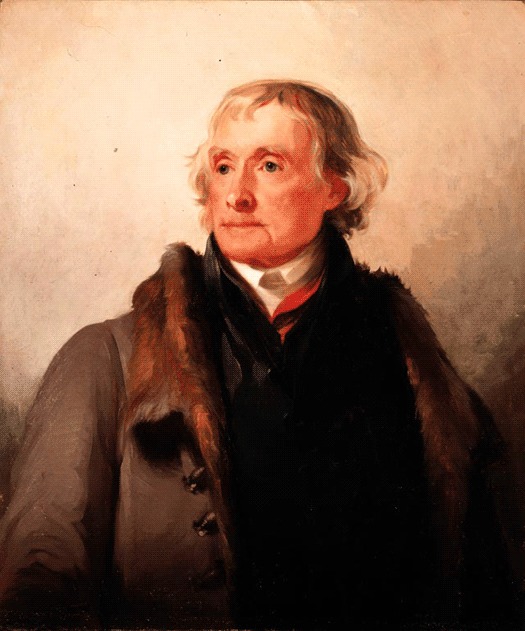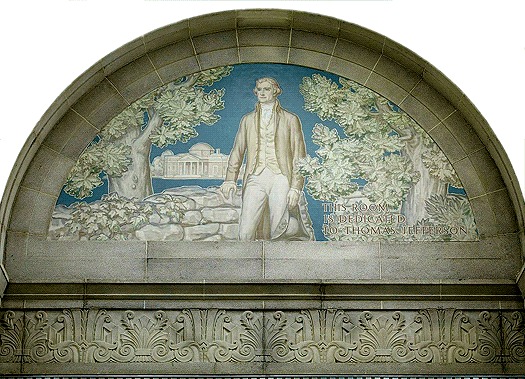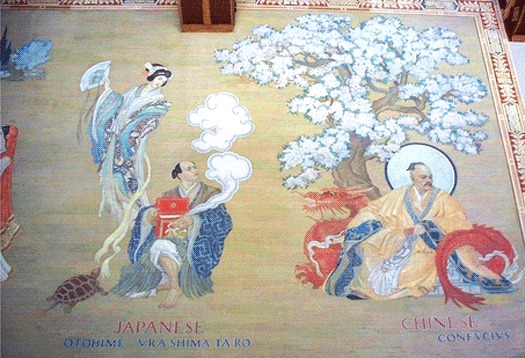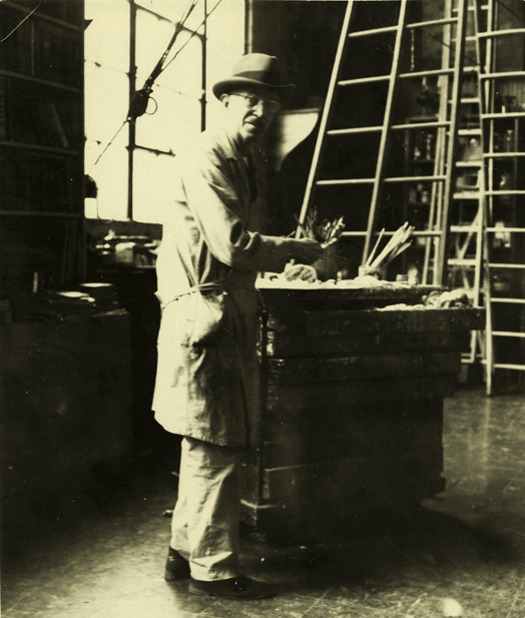Chapter Twelve : Colossus
1939. John Steinbeck publishes “The Grapes of Wrath”. Metro Goldwyn Mayer releases “The Wizard of Oz”. Germany invades Poland.
Ezra Winter, feverishly hard at work in his mountaintop studio, steeps himself in the Fourteenth Century, where he immerses himself in Geoffrey Chaucer’s Canterbury Tales.
On the walls of the North Reading Room in the Library of Congress, Winter paints the Miller and the Knight; the Parson and the Ploughman; the Carpenter and the Haberdasher; the Weaver and the Dyer. As ever, his command of visual form in the service of history is flawless, his fidelity to the characters at once deferential and dutiful. He has endlessly resarched their stories, imagined their clothing, engaged their interactions.

Detail illustrating the characters in the Canterbury Tales by Geoffrey Chaucer, on the east wall of the North Reading Room in the John Adams Building, Library of Congress
The plan for the South Reading Room, on the other hand, is to respond to the writings of Thomas Jefferson. And here, the process is not nearly as simple.
Winter works steadily, yet requests multiple extensions over the course of the next 24 months. Ever the perfectionist, he labors to create a likeness that will suitably reflect the spirit and nobility of this great statesman. At once inspired and overwhelmed by the drama of Jefferson’s impassioned language, the artist struggles to reconcile his historicist impulses with a more lyrical sense of humanity, frequently seeking feedback from his client, Archibald MacLeish.
“Do you know the magnificent portrait of Jefferson in the building of the American Philosophical society in Philadelphia?” MacLeish writes to him in December of 1940. “The face of that portrait is particularly moving to me.”
Painted over a period of nearly a decade by the English-born artist Thomas Sully, the portrait to which MacLeish refers shows a pensive Jefferson bathed in the warm cadences of chromium reds and yellows. The brushwork, while precise, is loose and spirited, the pose formal yet human.
 Portrait of Thomas Jefferson by Thomas Sully, 1856, oil on canvas
Portrait of Thomas Jefferson by Thomas Sully, 1856, oil on canvas Ezra Winter has spent a lifetime producing majestic murals filled with legendary heroes. From Sir Lancelot to Scheherezade, his are chisled figures, determined in their gaze, and grounded in their deference to historical custom. But the Jefferson portrait demands something more, and Winter must dig deeper. There is something heartbreaking about this process, one man working so intently to evoke the inner grace of another man, when the artist himself will, within the decade, struggle — and ultimately fail — to accept his own vulnerabilities, his own imperiled self.
Nevertheless, by late summer, 1941, Winter believes he has succeeded with the Jefferson portrait, and MacLeish agrees. And so, in mid-December — only a week after the bombing of Pearl Harbor — the South Reading Room murals are dedicated, and received to great public acclaim. "The draftsmanship is magnificent, the unbroken sequence of design quite extraordinary.," writes Leila Mechlin in The Washington Star. "There never has been, in the department of painting, so close an association as here between words and pictorial decoration."
 Mural of Thomas Jefferson with his residence, Monticello, in the background
Mural of Thomas Jefferson with his residence, Monticello, in the backgroundAnd then, on the heels of the Washington projects, a commission arrives from the Birmingham Library: thirty-six fairy tales are to be illustrated for the children’s library, while in the main reading room, Winter will draw from world literature to produce a series of murals that nod to the Western tradition (Dante and Molière, Cervantes and Faust) as well as Biblical allegory. Included, too, are examples taken from Russian, Scandinavian, Egyptian and Persian folklore.
By far the most beautiful of these draws its inspiration from an Eighth-Century Japanese fable about a Sea Princess who rescues a fisherman and brings him to the bottom of the sea on her magic turtle. When, several days later, he asks to return to his small village to visit his ailing mother, she gives him a box, which she instructs him not to open. But when the fisherman arrives home to discover that 300 years have passed, he is grief-stricken and forgets the Princess’s warning. Upon opening the forbidden box, he is enveloped by a cloud of white smoke, and instantly becomes an old man.
Nine years after the Radio City murals, Winter returns to his obsession with the fleeting nature of youth.

Left, Winter's mural depicting the Japanese sea princess, Otohime, and the story of Urashima Taro; right, his illustration of the Chinese philosopher, Confucius
With a war in Europe, the economy in slow recovery and architectual decoration no longer in vogue as it once had been, the demand for Ezra’s murals begins to subside. Requests, once national in scope, are more local and infrequent. Commissions, once grand, come few and far between. He is invited to participate in several small group shows, to contribute art for a calendar, to jury a local exhibition. Speaking invitations come in less for Ezra than for Pat, who travels and lectures and is often interviewed in the national press. Witnessing his wife’s meteoric rise (and by conjecture, her increasingly healthy earnings) would have been deeply unsettling to a man of Winter’s generation, and indeed, he gradually becomes more sullen and withdrawn. His moods become volatile, his focus uneven. Pulled over for driving without proper identification in the summer of 1945, his license is temporarily suspended.
And then, while working on a seventh mural for the Bank of Manhattan, the artist slips and falls from a scaffold, fracturing his coccyx. It is an inoperable injury, painful and slow to heal. Gradually, he begins to exhibit behaviors that suggest his health is in decline. In a letter to Vera, he makes reference to a “recurring illness” and a “nervous condition” that have made it impossible to meet certain professional deadlines. He complains of an ear infection, a throat condition, and headaches which he claims are constant. For the first time in his life, he can not hold a paintbrush.
He is 63 years old, and he is despondent.

Ezra Winter, about 1947, in his studio in Falls Village, in one of the last photographs ever taken of him.
In the end, Ezra Winter was a man whose devotion to the classical world virtually underscored his every move. It explained his ineffable pursuit of youth, his enduring worship of women, his unyielding obsessions with fantasy and grandeur, lyricism and scale, theatricality and costume, fable and myth. Winter’s pursuit of all things beautiful had, for over half a century, sustained his spirit — but even this could not possibly endure. His youth decidedly behind him, his future persistently in question, it seemed as if the magnificence of the Beaux-Arts world which had for so long framed his vision was beginning, ever so slowly, to crumble. His orbit — once defined by massive ateliers and acres of farmland, by national fame and palpable celebrity — was growing smaller. Years later, a local writer would refer to the Falls Village studio as a colossus — a reference to the Colossus of Rhodes, one of the original seven wonders of the ancient world, but more commonly, perhaps, a synonym for scale and power, both of which would long remain hallmarks of Winter’s prolific, if now all but forgotten, career.
“Beauty,” Albert Camus once wrote, “is unbearable... (and) drives us to despair, offering us for a minute the glimpse of an eternity that we should like to stretch out over the whole of time.” Perhaps that’s what Winter imagined on that crisp April morning in 1949. Perhaps, in that minute — overcome by hopelessness, beset by weariness, his spirit dry and his optimism eviscerated — this seemed a plausible thought. Perhaps, in those last few precious moments of his life, before he raised a gun to his temple, that is exactly what he hoped to restore: not the grandeur of his lost youth or the scale of his greatest achievements, but a single glimpse of one last magical eternity, where ageless beauty could finally triumph, undisturbed by the savage mysteries of the modern world.
(Please wait while the video loads.)
Additional research provided by Eileen Schmidt. Music: First Aid Kit / Winter is All Over You 

Comments [1]
01.01.13
01:54